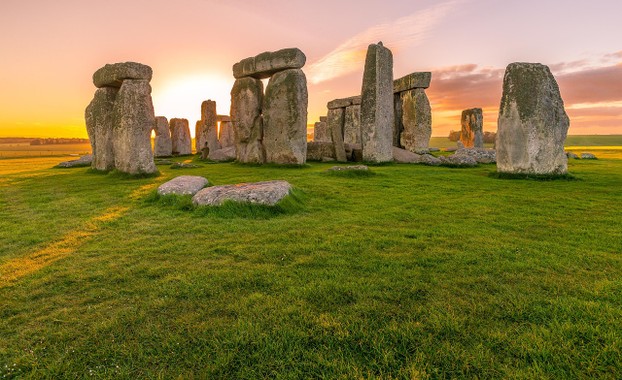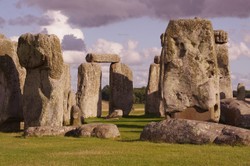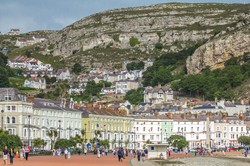Perhaps one of the great pleasures of Archaeology is that it feeds dreams. People have dreamed of the origins of this megalithic relic and they have let their imaginations take flight, seeing white clad druids, almost certainly not realistic and sacrifices on the recumbent altar stone, itself a name deriving from the imaginal wanderings of minds in later years. But imagination is not mere fancy, for certainly it allows us to wander in the far past and takes us to truths that strict rationality cannot give us. A geologist has discovered that rather than being of local origin in the Stonehenge region, the altar stone came from Northern Scotland, probably from the sacred islands of Orkney.

Surprise at Stonehenge
by frankbeswick
Archaeologists have puzzled about the origins of the stones at Stonehenge. But progress in knowledge brought a surprise.
A Long and Arduous Passage.
The fate of most humans is to be forgotten, we make exploits that enable us to stride across the firmament of fame for brief times, but then we fade, and so many exploits of early humans have been lost to memory. In this article I am going to draw on the imagination to celebrate the exploits of the creators of Stonehenge. I will assume that having teams of humans dragging the stone all the way from North Britain to Stonehenge is unfeasible, and that anyway as the journey from Orkney involves a sea passage, it is not uniminaginable to say that a maritime route for part of the journey,maybe a substantial part, is feasible.
Some four thousand years ago, a fleet set off from Orkney. The bulk of the boats were dug out canoes or cows' hide vessels akin to the curraghs used even today by the western Irish fishermen. Tanned and greased hides were favoured for their waterproofing abilities in that early age. Yet other vessels were rafts, we do not know how many, and at least one raft carried a roped down sandstone block destined for a new temple in the southern land yet to be named England. Other rafts, which like the main raft were towed behind many of the canoes, carried provisions and spares, for the crews were embarking on a seven hundred mile journey, taking their maritime technology to its limits. Perhaps the crews had embarked on the northward voyage already, going north to take possession of the stone, so they were veteran voyagers already.
We must not think of the voyages as exclusively male, for when tribes made long journeys their women came with them, a practice done by Native Americans. Women were essential for mending and making clothes and took responsibility for cooking. Children, some maybe babes still at the breast, may also have been on the journey, their destiny, the new temple of Stonehenge where they would deliver an altar stone. The journey would be seven hundred mIles each way. The women were not mere passengers or second class voyagers, they were there to maintain the well being of the crew.
The first step in the voyage would be to cross the clashing tidal streams that meet where the tidal waters of the North Atlantic meet the currents from the North Sea, when the colliding waters create a confused surface which we call an overfall nicknamed the Merry Men oF Mey, with water columns and pits occurring spontaneously. But safely past this hazard, mariners can coast past Northern Scotland then turn southward, hugging the British coast. Then it is that direction for about six hundred miles.night time would involve coming ashore at the land of friendly tribes and cooking some food on an open fire, and possibly resting when someone took ill.
Stonehenge
 Sunrise at Stonehenge Freesally |
The Context of the Voyage
It was customary in my younger years to hear people disparage the ancient Britons as long-haired, woad-painted barbarians clad in skins. This is Graeco-Roman snobbery which does no justice to our forebears, especially when it comes from a nation like Rome whose people entertained themselves with gladiators fighting often to the death.
But the architects of Stonehenge worked out the design in a precise mathematical way. They had a precise system of geometry and had a knowledge of the stars and used it as an element integral to the geometric design of their constructions. Both Britain and Ireland, which in the early Neolithic Age had similar cultures and were inhabited by related peoples, had mathematical and astronomic knowledge which they used in the design of tombs
While scholars have traditionally thought of the Britons as a collection of disjointed tribes the people of these isles were making goods and trading them over long distances by land and water.The fact that Britons from what is now Southern England could enter an agreement to trade a large stone shows that not only were there wide trading networks in Britain, but that navigation was sufficiently advanced to make the voyage feasible and profitable.
Archaeologists have speculated that Orkney was the roots of the cultus represented by Stonehenge and this astronomically constructed temple was the blueprint for the design which became common across the British Isles. That the design proved common shows that there was a cultural zone that spread across Britain, and for this to happen there needs to be transport and communication systems that can provide the basis for a system of shared beliefs and values. Thus the single megalith from Orkney reveals a whole cultural network. Th need to have a block of stone from Orkney for an honoured location in the new temple may be due to the southerners' perceived need to have a fragment of the holiness of the Orkney temple in the new one. It is akin to the Catholic custom of having relics of saints in an altar stone, a box concealed on the altar at mass.
Destination Reached.
The navigator, an experienced seafarer, had been scanning the coast for landmarks. The voyagers had passed the Humber estuary, where they would have spent the night upon the open expanses of flat land. The shallow bay of the Wash had gone by with no room to stop, for the marshy fens were not a desirable stopping ground. The voyagers were keen eyed for the Thames. At last the wide estuary of the Thames hove into view and the navigator signalled for a starboard turn. But then he had to start the tricky task of navigating estuarine waters, harder to perform than coping with the comparatively simpler sea water. His trained eye read the signs in the waves, exercising a skill practised by ancient sailors, but lost to moderns. The enclosing banks began to narrow the passage of navigable waters, so the navigator sent his eldest son in a canoe kept on the deck of one of the rafts to sound out a navigable passage. After all, the tribe had paid heavily for this magical stone: flint tools from southern lands, hard stone ax heads traded from the rugged landscapes of the North, gold jewellery mined in the misty mountains of the west of Ireland, and a chieftain's daughter as a bride for a young nobleman in the Orkneys.
The route up the river which began with the Thames eventually joined the Thames' tributary' the Kennet, which would have taken the fleet all but the last thirty miles to Stonehenge. This is the part of the journey which had to involve muscle. The voyagers would have been slowly paddling upstream, against the seaward flow of the river, hard work and slow, but time enough for plans for the final stage to be drawn up. The traditional image is of teams of Britons dragging heavy stones across the ancient landscape. But was there not an easier way? The Neolithic and Bronze Age Britons kept cattle. Had they discovered the pulling power of oxen? Certainly teams of oxen could do the job of moving the stones far better than humans could.
With the stone resting safely in place the ancient Britons could turn to their favourite activity, feasting. Archaeological work has found evidence of great feasts in which pigs were consumed in large quantities. along with beer. Pork and ale along with music and dancing. Life does not change much over the generations.
I am an Amazon associate and earn money from qualifying purchases on this page.
You might also like
A Strong Woman's StoryJane Evans went to War, but fought no one, for her mission was mercy and kind...
Sarn Helen. Through Wales on footSarn Helen is a Roman route which travels Wales from South to North, and the...






 TheThousand Year Gardenon 11/26/2025
TheThousand Year Gardenon 11/26/2025
 Women of the Gospelson 10/11/2025
Women of the Gospelson 10/11/2025
 Religious Gardenson 08/25/2025
Religious Gardenson 08/25/2025
 Doctor of the Church: John Henry Newmanon 08/03/2025
Doctor of the Church: John Henry Newmanon 08/03/2025



Comments
No. Lanolin is extractable frommthe fleece, the acquisition of which does not require the death of an animal.
Thank you for your comment below in answer to my observation and question.
Cow-hide vessels demand the death of cattle even as dairy and wool products do not demand the death of sheep.
Does lanolin grease demand the death of sheep?
Cow hide vessels were used in Ireland to the last century. They have a frame of oak and a skin of hides greased with lanolin, sheep grease.
The second paragraph to the first subheading, A long and arduous passage, alerts us to "cows' hide vessels."
Did those vessels use cow-bones or wood to support the cow hides?
Yes. May is the correct pronunciation.
Thank you for your comment below in answer to my previous question.
Unitedstatesians might pronounce Mey like the month of May. Would that be what British Isles-ers do?
Daughter or maiden strikes me as the most likely, as why would anyone want to name a castle after a very ordinary flower.
Thank you for your comment below in answer to my previous observation and question.
English Wiktionary associates mey with Old Norse for "daughter, maiden" and with Scots for "hawthorn flower."
Which might be more possible?
Probably Norse.
Thank you for your comment below in answer to my previous observation and question.
Mey appears in area names for a a bay, a castle, a loch and a village. No online source gives its etymology. What language is it from?